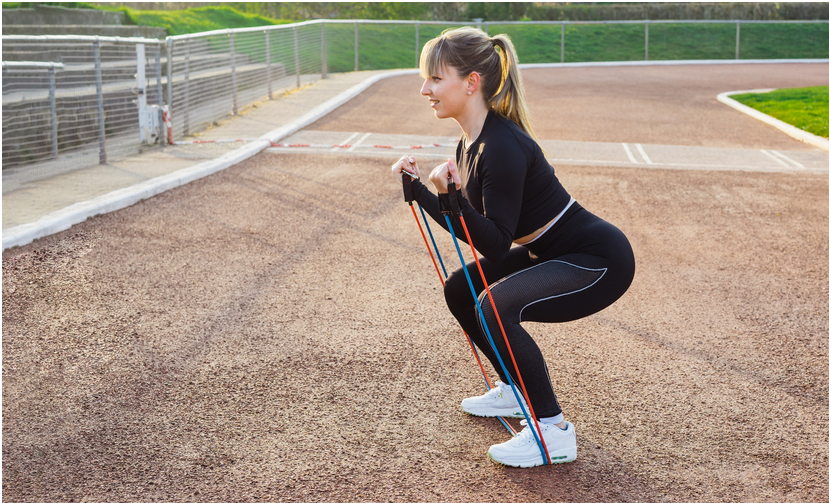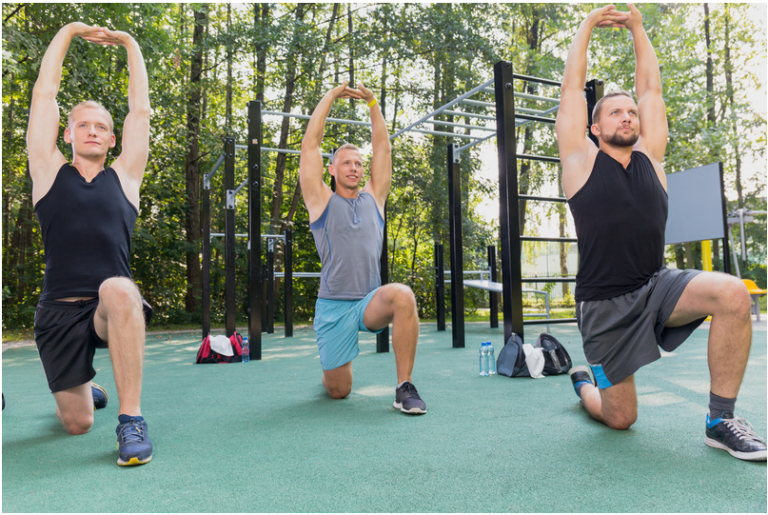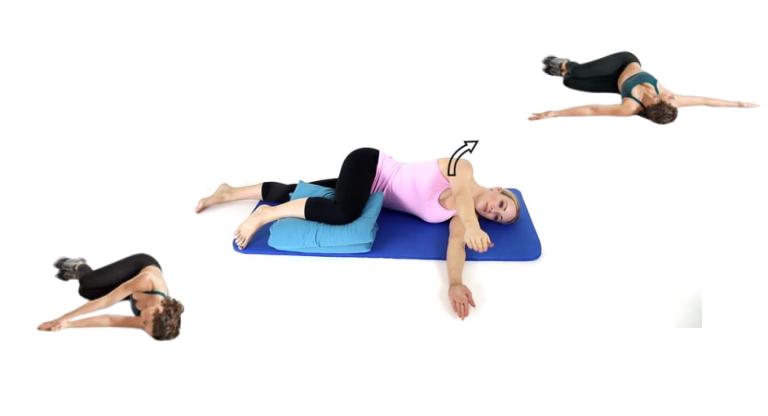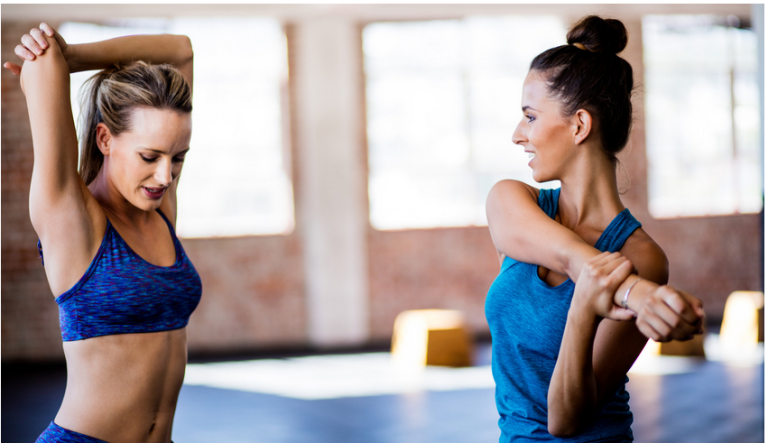
Resistance Stretching: The Ultimate Flexibility System

If one is at odds with just what resistance stretching is, it can most readily be understood by its fundamental principle: your body moves in a specific motion while a resistive force counters its motion.
This principle can be performed on oneself, with a partner, or with a stretch strap and is what distinguishes resistance stretching from other forms of stretching. Bob Cooley expands on this with specific examples, emphasizing its the warm up of an action of sports movement with a therapy strength exercise.
He further illustrates it with the comparison of elongating taffy. Influence it correctly and the taffy is slim and long, influence it too quickly and it breaks. If this concept is followed, it is theoretically possible to re-educate a muscle or muscle group on optimal function by changing the rate of resistance over its range. He also speaks of the mythic parasympathetic reflex principle of non-resistive slow stretching.
This principle states that exclusively by turning off the stretch reflex and elongating a muscle slowly will bring about a long-term benefit in muscle length. It is claimed that this form of stretching has bettered anticipated results but has been proven to be false. Cooley sets the pace for the remaining chapters by foreshadowing a prophecy of what resistance stretching can do regarding safety and results in greater lengthener of muscles and flexibility.
By the end of this article, you will better understand resistance stretching and how it can help you achieve your flexibility and fitness goals. Read on to discover the genius of flexibility!
So, What is Resistance Stretching?
Resistance stretching is a type of stretching that was originally developed in the 1940s by a man named Jules Stei. He originally termed this method “Spinal Evaluation,” but it has since changed to a more advanced technique and taken on the name “Resistance Stretching.” Simply, it is any method of stretching that is resisted. This can include PNF methods, yoga methods, or any technique of stretching where the muscle is contracted for a period of time while it is being stretched.
This type of stretching may be more effective than static stretching because it changes the structure of the muscle. It can effect change in muscle “shortness” by elongating the muscle, whereas static stretching may simply increase the pliability of the muscle. And it can be more effective in that contraction of a muscle takes place at the neuromuscular level and to “convince” a muscle to lengthen, one must get the cooperation of the muscle spindles.
What are the benefits of resistance stretching?
There are a variety of benefits to practicing resistance stretching. Resistance stretching provides the way with the most lasting gains of flexibility. It works by increasing the fascial plasticity; it actually realigns the displaced and stuck tissue. This is all made possible since the constant tension in resistance stretching tricks the brain’s protective mechanisms into allowing the stretch. Since the resistance has to be held for the whole duration of the stretch, it guarantees an isolated and complete muscle stretch. This means that muscle groups won’t be able to compensate for the lack of flexibility in a certain muscle, a common problem in other stretching methods.
This then reduces the risk of faulty movement patterns which can lead to injury. Another advantage of resistance stretching is that it simultaneously increases strength of the stretched muscles. This is since resistance stretching trains muscles to produce force in a lengthened position, something that no normal strength training can do. Research has shown that an eccentric contraction (contraction of a muscle in a lengthened position) can produce greater gains of both strength and flexibility than any other form of flexibility training.
How resistance stretching works

The basic principle behind any flexibility training is to elongate the muscle fibers. In traditional stretching methods, a position is assumed that is held for a time until the muscles eventually relax and allow for greater elongation as the position is increased.
This is known as the Autogenic Inhibition reflex, which is the process of a muscle relaxing to protect it from reaching too high a tension. It has been suggested that holding a static stretch for a prolonged period will eventually fatigue the stretch reflex and allow the muscle to relax and increase its length. However, research into the nature of connective tissue and the viscoelastic properties of muscles has shown that static stretching may not be the most effective means of elongating muscle fibers.
Resistance stretching is often dismissed as being “more effective” than other methods of flexibility training, with very little explanation as to how or why this is so. We are left with a very vague understanding and the impression that it is simply a matter of pushing harder on the muscles. In reality, this method of contract-relax involves complex physiology and delicate reflex mechanisms. To understand the exact science of stretching, we need to look at the Articulatory Method taught in The Genius of Flexibility and how it relates to simple static stretching.
What are the types of resistance stretching?
There are different types of resistance stretching, depending on the source and direction of the resistance. The main types are:
- Self-resistance stretching. This is when you use your own body weight and muscle force to create resistance. You can do this by pushing or pulling against your limbs or using a wall or a floor as a support. This type of resistance stretching is convenient and accessible, as you don’t need any equipment or partner. However, it can be challenging to control the intensity and duration of the resistance, and your strength and flexibility can limit it.
- Partner-resistance stretching. This is when you use another person to create resistance. You can do this by having your partner push or pull your limbs or using your partner’s body weight and muscle force as a counterbalance. This type of resistance stretching is effective and fun, as you can have more feedback and variety in the resistance. However, finding a suitable and reliable partner can be difficult and risky if your partner needs to be trained and careful.
- Equipment-resistance stretching. This is when you use a device or a tool to create resistance. You can use resistance bands, free weights, machines, or other gadgets to provide tension and resistance. This type of resistance stretching is versatile and adjustable, as you can have more control and options in the resistance. However, it can be expensive and cumbersome, as you need to buy and carry the equipment, and it can be complicated to use and set up.
Each resistance stretching type has pros and cons, and you can choose the one that suits you best. You can also combine different types of resistance stretching, depending on your preferences and availability. The important thing is to apply the resistance correctly and safely, following the principles and guidelines of resistance stretching.
How to do resistance stretching exercises
Resistance stretching exercises are similar to regular stretching exercises but with the addition of resistance. The general procedure is as follows:
- Choose a muscle group or joint you want to stretch and strengthen.
- Choose a type of resistance stretching you want to use (self, partner, or equipment).
- Choose a direction of resistance that you want to apply (eccentric or concentric), as recommended by Bob Cooley in resistance flexibility and strength training.
- Assume a starting position allowing you to contract the muscle you want to stretch.
- Apply the resistance while you move the muscle from a contracted position to a stretched position or vice versa.
- Hold the resistance and the stretch for a few seconds, or repeat the movement a few times.
- Release the resistance and the stretch, and relax the muscles.
- Repeat the exercise for the same muscle group or joint, or switch to a different one.
Resistance Stretching Examples
Here are some examples of resistance stretching exercises that you can try using different types of resistance and directions:
- Hamstring stretch with self-eccentric resistance. Lie on your back with your legs straight and your arms by your sides. Lift your right leg and bend your knee, bringing your heel toward your buttock. Grab your right ankle with your right hand and pull your heel closer to your buttock, contracting your hamstring. This is a basic exercise in resistance flexibility workouts. Then, slowly extend your right leg, resisting the movement with your right hand and stretching your hamstring. This technique is a fundamental part of resistance flexibility and strength training. Hold the stretch for a few seconds, then return to the starting position. Repeat the exercise with your left leg or switch to a different muscle group or joint.
- Biceps stretch with partner-concentric resistance. Stand facing your partner, with your arms extended in front of you and your palms facing each other, ensuring a 3 resistance level during the stretch for optimal results. Have your partner hold your wrists and push your arms outward, contracting your biceps. Then, have your partner pull your arms inward, resisting the movement with your biceps, stretching your biceps. Hold the stretch for a few seconds, then return to the starting position. Repeat the exercise or switch to a different muscle group or joint.
- Chest stretch with equipment-eccentric resistance. Stand with your feet shoulder-width apart, and hold a resistance band with both hands at chest level. Extend your arms to the sides, creating tension in the band and contracting your chest. Then, slowly bring your arms to you, resisting the band and stretching your chest. Hold the stretch for a few seconds, then return to the starting position. Repeat the exercise or switch to a different muscle group or joint.
These are just some examples of resistance stretching exercises you can do using different types of resistance and directions. You can find more exercises online or create your own, following the principles and guidelines of resistance stretching.
How to incorporate resistance stretching into your workout routine
Resistance stretching can be a great addition to your workout routine, as it can improve your flexibility and strength, as well as your posture, performance, and well-being. However, you must be careful and smart about incorporating resistance stretching into your workout routine to avoid overdoing it or injuring yourself.
Here are some tips and recommendations on how to incorporate resistance stretching into your workout routine:
1. Start slowly and gradually
If you are new to resistance stretching, you must be careful and gentle with your muscles and joints, as they might not be used to the resistance and the stretch. Start with low intensity and short duration, gradually increasing them as you become more comfortable and confident. Listen to your body and stop if you feel any pain or discomfort.
2. Warm-up and cool down
As with any exercise, you must warm up before and cool down after resistance stretching to prevent injury and enhance recovery. A warm-up can consist of light aerobic activity, such as jogging, cycling, or skipping, followed by dynamic stretching, such as arm circles, leg swings, or torso twists. A cool-down can consist of static stretching, such as toe touches, quad stretches, or shoulder stretches, followed by relaxation techniques, such as deep breathing, meditation, or massage.
3. Be consistent and progressive
You must be consistent and progressive with your practice to see the best results from resistance stretching. Aim to do resistance stretching at least twice weekly, preferably on non-consecutive days, to allow your muscles and joints to recover and adapt. Also, try to increase the intensity, duration, and variety of your resistance stretching exercises over time to challenge your muscles and joints and avoid plateaus.
4. Mix and match
Resistance stretching can be done as a standalone workout or complement your other workouts. You can mix and match resistance stretching with other types of exercise, such as weight training, aerobic training, or yoga, to create a balanced and effective fitness program that includes flexibility training. For example, stretching resistance before weight training warms up and activates your muscles and joints. Or you can do resistance stretching after aerobic training to cool down and relax your muscles and joints. Or you can do resistance stretching on your rest days to recover and improve your flexibility and strength.
5. Have fun and enjoy
Resistance stretching can be a fun way to improve your flexibility and strength, as well as your posture, performance, and well-being. Depending on your preferences and availability, you can do resistance stretching alone, with a partner, or with a group. Depending on your needs and goals, you can also experiment with different types of resistance, directions, and exercises. It is important to have fun, enjoy the process, and appreciate the benefits of resistance stretching, especially its role in flexibility and muscle strength enhancement.
Summary
Resistance stretching is a revolutionary flexibility system that combines stretching and strength training to improve your flexibility and strength, as well as your posture, performance, and well-being. Resistance stretching works by activating your muscle fibres specifically, using two types of resistance: eccentric and concentric.
There are different types of resistance stretching, depending on the source and direction of the resistance: self, partner, or equipment-based, each offering unique benefits to a resistance training program. Resistance stretching exercises are similar to regular stretching exercises, but with the addition of resistance. Resistance stretching can be incorporated into your workout routine by following some tips and recommendations.
Here are the main points to remember from this article:
- Resistance stretching helps you lengthen and strengthen your muscles while enhancing your flexibility and strength. This is a core principle of resistance flexibility training.
- Resistance stretching involves contracting your muscles while stretching them, creating resistance from within your body.
- Resistance stretching is based on the principle that your muscles have two functions: to contract and to resist.
- Resistance stretching works by activating your muscle fibres specifically, using two types of resistance: eccentric and concentric.
- There are different types of resistance stretching, depending on the source and direction of the resistance: self, partner, or equipment.
- Resistance stretching exercises are similar to regular stretching exercises but with the addition of resistance.
- Resistance stretching can be incorporated into your workout routine by following some tips and recommendations.
We hope you enjoyed this article and learned something new about resistance stretching. If you want to try resistance stretching, find more information and resources online or consult a qualified professional in resistance flexibility training. Resistance stretching can be a great way to improve your flexibility and strength, as well as your posture, performance, and well-being. Give it a try and see the difference for yourself!
References
- Influence of 8-weeks of supervised static stretching or resistance training of pectoral major muscles on maximal strength, muscle thickness and range of motion
- Resistance Training Induces Improvements in Range of Motion: A Systematic Review and Meta-Analysis
- Chronic Effects of Static Stretching Exercises on Muscle Strength and Power: A Systematic Review and Meta-Analysis



